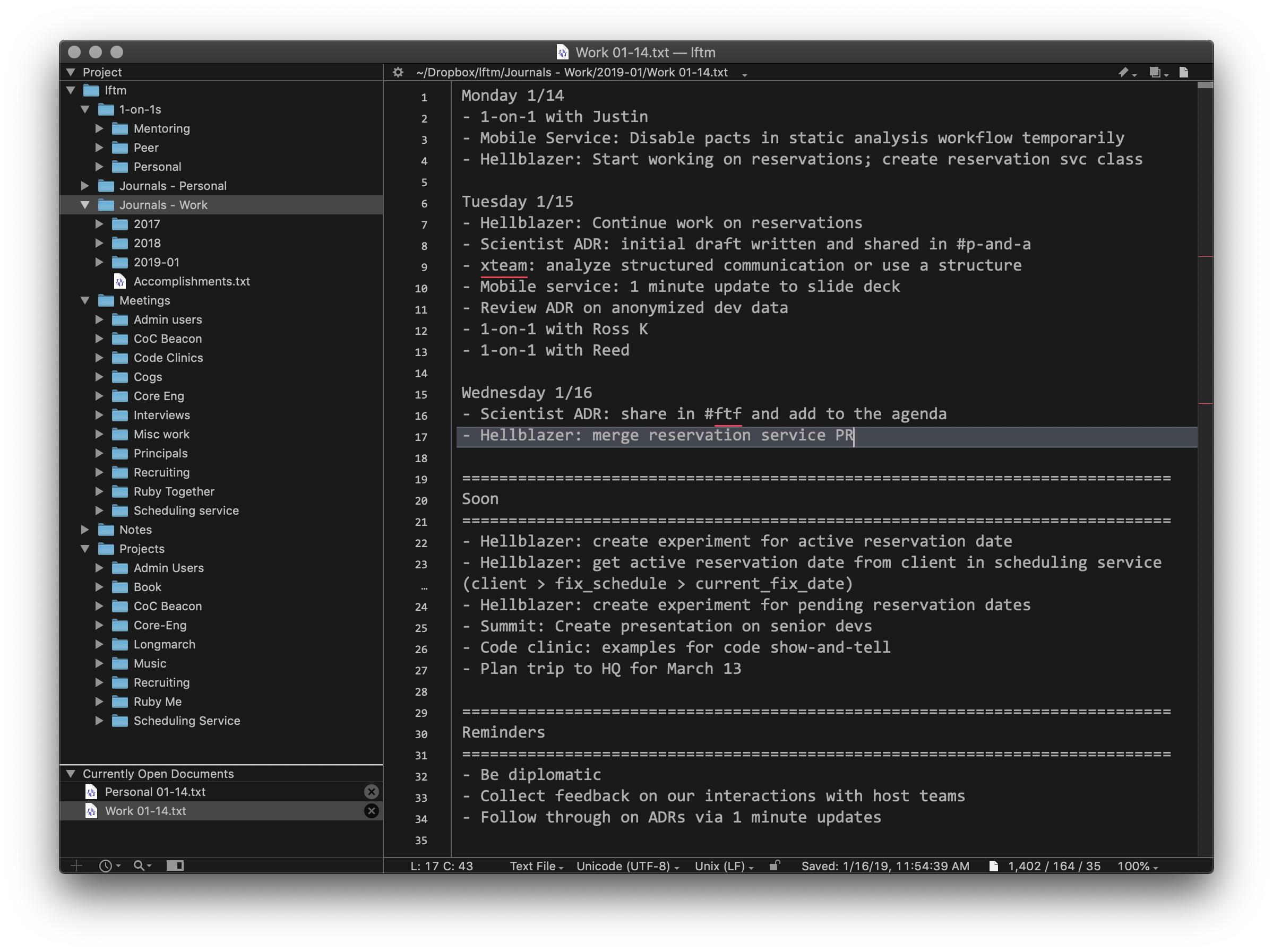lftm
A low-friction task management system. Like a productivity app, without the app.
Background
I have tried every GTD approach and productivity tool under the sun. Without fail they fall into two camps: not enough organization, or far too much organization. I finally developed a system that works well for me, is low-friction, and keeps me organized.
The system has several benefits:
- Answers the question of 'what do I do next?', which is the ultimate productivity killer.
- Keeps my working memory uncluttered.
- Keeps me from um'ing during my daily standups. I always know what I worked on yesterday.
- Is a handy record of accomplishments that I can reference when it's time for my review, I want to ask for a raise, or I'm updating my resume.
- Provides a reminder that I do, in fact, get things done and that I don't, in fact, suck at my job.
The system consists of a number of folders, each containing a specific kind of text file. I use BBEdit and open the parent folder as a project so that I have all of my subfolders in a tree view with easy access to their enclosed documents. You should be able to do the same thing in the editor of your choice.
Folder Structure
1-on-1s
Keep a separate document for each person with whom you have regular 1-on-1s. Make date headings, and keep it updated with things that you talked about. Add a "Next Time" header to track a backlog of topics or as a periodic reminder to check in on something. Before your 1-on-1, open the document to review your last session and remind yourself of the things that you want to talk about.
During the meeting or immediately afterward, write down anything else that you talked about and capture action items. After the meeting is over, transfer the action items to your work journal under the Soon heading.
Meetings
For recurring meetings, keep a single document named for the meeting title. Jot down notes either during the meeting or immediately after. Capture action items as you go, and transfer them to your work journal when the meeting is over.
Journals
Make a folder for each month and one document for each week. Never work in advance.
Daily Headings In the weekly document, you should have a heading for the current day and any previous day; avoid adding headings for the future (that's what calendars are for.) Pro tip: prefix line items under each daily heading with the project name, for easier searchability. Example:
- Hellblazer: create experiment for pending reservation dates
- Summit: Create presentation on senior devs
- Code clinic: examples for code show-and-tell
Soon Heading
You should also have a heading for Soon items, which are action items on your backlog. It's fine to arrange them in priority order / stack rank them, but don't stress too much over this.
Reminders
I also have a heading for Reminders, which consist of actionable feedback that I have received or goals for myself relating to my interactions with others. Example:
- Think about how I want the other person to feel before saying something
- Prioritize and optimize for impact and leverage
- Turn critics into collaborators
Retrospectives
Inside the personal and work journal folders are files called retrospectives.txt. I recommend filling out the work version on Friday at the end of your day, and the personal version on Sunday evening. This is a personal retrospective that gives you a place to reflect on your overall feelings about your week, what you accomplished, the people who helped you the most, and also the people that you helped. Take your time filling these out-- self-reflection goes a long way toward a sense of accomplishment and reinforces your good work.
Projects
Keep all your project notes in one place. Create a subfolder for each project, and one or more files in that subfolder for notes, goals, meetings, and so on. It's okay to have tasks in the project, just make sure to surface the ones that you will need to get to soon under the 'Soon' header in your work journal. This will actually help that 'Soon' group from growing too large to manage.
Notes
Create a separate document for each project that you have planned or in the works. Write down your thoughts and ideas, paste in URLs of relevant project docs, and write preliminary to-dos. Don't worry about over-organizing: this is a place for you to brain dump and free your mind from having to remember a thousand details.
How to Use The Journal
When you start your day, pull a couple of items from your Soon heading up into the current day. As you work, take a few seconds to update the daily heading with what you're working on. Write down every task you completed or started, even if it feels minor. This will reinforce your self-image as a productive person and give you confidence in your ability to Get Shit Done.
